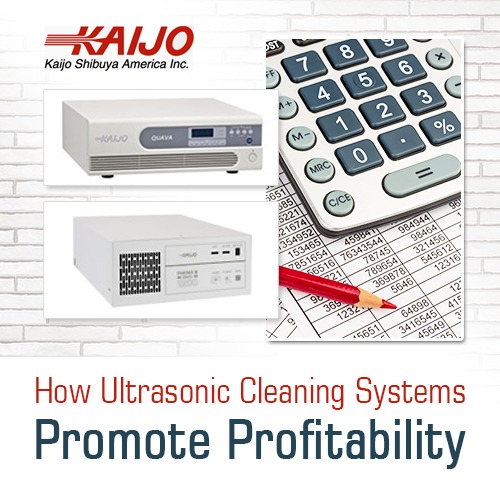How Ultrasonic Cleaning Systems Promote Profitability
January 19, 2018

Conventional degreasing and other cleaning processes involving the use of pressure cleaning, solvent and abrasives are on their way out in many industries. The change has come about for a number of reasons. The movement of industry towards green processes is one reason — solvents are often toxic to the environment. New environmental regulations being put in place by various state and local governments make it very hard for industries to get around, as well.
Cost- and efficiency-related concerns, however, have been the primary reason for the move away from conventional cleaning techniques. The chemicals needed in these approaches can be expensive, and can require further expense in the protection of the workers who use them. Safe disposal of toxic residue and the requisite inspections can take considerable investment, as well.
Yet, effective cleaning is essential to a great many industrial processes. From the immaculate surfaces needed prior to the application of powder coating processes, to the cleaning of high-tech filters and bearings at NASA, and from the jewelry industry to the automotive industry, safe, cost-effective and superior cleaning technology is a great need.
In Search of a More Affordable, and Cost-effective Cleaning Approach
In many industries that require the cleaning of industrial parts or other articles of various sizes, ultrasonic cleaning systems have proven to be the method of choice for a number of important reasons.
The action of ultrasonic energy on certain surfaces is observed in a number of scenarios. Anyone who is familiar with boats, for instance, has usually seen some damage to propellers — ultrasonic energy generated in the churn of propellers can be uncontrolled in its power; it often excavates tiny pits in the metal. When this energy is applied in a well-controlled manner, however, it can be used as a powerful cleaning agent.
Ultrasonic energy works in a very simple way — when dense, elastic media such as water is subjected to high-frequency energy, it expands and contracts so rapidly as to cause millions of microscopic fractures or tears. The small bubbles that are created collapse quickly after they are formed, often with great force. When such vacuum bubbles collapse close to the surface of an object, the force can knock surface contaminants off. Ultrasonic cleaning systems successfully apply ultrasonic energy to perform a great deal of useful work.
How do Ultrasonic Cleaners achieve their Effect?
Ultrasonic cleaning units consist of a tank usually filled with water, coupled to a powerful ultrasonic transducer capable of generating high-energy ultrasonic frequencies between 20 to 200 kHz. When objects to be cleaned — anything from industrial parts to dental equipment and jewelry — are placed in the bath, the ultrasonic waves generated create millions of cavitation bubbles. Localized areas can experience pressures over 10,000 psi, and temperatures over 10,000°F; dirt is effectively knocked off. Since these pressures and temperatures are created over microscopic areas, however, there is never any harm done to the work to be cleaned.
How are Ultrasonic Cleaners Superior to Conventional Cleaning Solutions?
Every nook is reached: With conventional cleaning — the pressure sprayers, solvents and abrasives — the cleaning action can often only reach areas clearly exposed. Ultrasonic energy, however, is able to get to hidden, unexposed areas.
The cleaning tends to be thorough: With cavitation bubbles forming and imploding in their millions, there is cleaning action in a way no water jet or abrasive can ever achieve. Even more importantly, the cleaning is achieved with little surface damage done, something that can be very important in the high-tech industry, the jewelry industry, or even the automotive industry, where delicate engine seals and finishes may need attention.
Insoluble contaminants are cleaned: Solvents are able to clean soluble contaminants; many contaminants, however, are simply resistant to the effects of solvents. Ultrasonic energy simply displaces such contaminants without the need for abrasive action.
Ultrasonic cleaners Help the Bottom Line
With such powerful and safe cleaning ability, the toughest cleaning jobs are usually completed in under an hour, with little need for supervisory personnel, or the need for the toxic waste disposal. With practically no moving parts, these appliances tend to require minimal maintenance, as well.
Ultrasonic cleaning systems are not all made the same. Kaijo, an industry leader in ultrasonic cleaning, has been at the cutting edge of the technology for over 65 years, developing purpose-built ultrasonic cleaning solutions for every industrial application. With the latest in ultrasonic cleaning deployed in practically every industry around the world, Kaijo has more experience with this technology than nearly any other name in the business.





